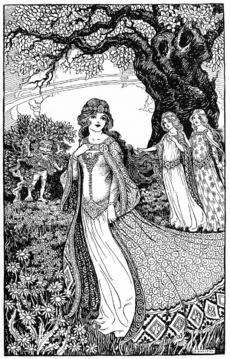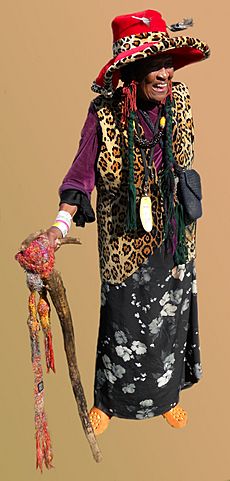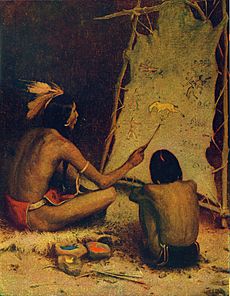Storytelling facts for kids
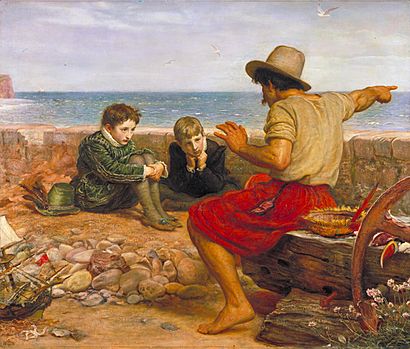
Storytelling is a fun and important way people share stories. Sometimes, storytellers use improvisation, acting, or add extra details to make the story more exciting. Every culture has its own special stories. These stories are shared to entertain, teach, keep traditions alive, or share important moral lessons. Key parts of any story include the plot (what happens), the characters (who is in it), and the point of view (who is telling it).
The word "storytelling" can mean telling stories out loud. But it also means how stories are shown in movies, books, and other ways.
Contents
History of Storytelling
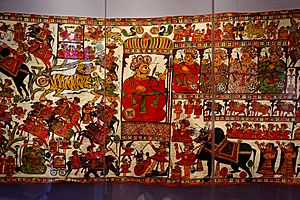
Storytelling has been around for a very long time, even before writing was invented. It grew alongside myths and ancient beliefs. The first stories were usually told out loud, using hand gestures and facial expressions.
Some experts think that rock art (paintings on rocks) might have been a way for ancient cultures to tell stories. For example, Australian aboriginal people painted symbols on cave walls. These symbols helped the storyteller remember the tale. The story was then told using spoken words, music, rock art, and dance. This helped people understand their lives and history. People also carved stories into living trees or used things like sand and leaves to record folktales. Even complex tattoos could tell stories about a person's family, group, or social status.
Many folktales from different places often share similar ideas and themes. This suggests that people across cultures might think in similar ways. Other stories, like fairy tales, spread from one place to another because they were so popular.
Over time, groups of stories told out loud could become story cycles. Think of Arabian Nights! Stories also grew around famous heroes like King Arthur. They even became tales about gods and saints in different religions. These stories could be like TV shows with many episodes (like tales about Anansi). They could be long poems (like Homer's epics). Or they could be inspiring (like stories about saints) or teach lessons (like many Buddhist or Christian scriptures).
When writing was invented, and people could use things like paper, storytellers could record and share stories far and wide. Stories have been carved, painted, printed, or written on many different materials. These include wood, bamboo, stone, clay tablets, and paper. Today, stories are also recorded on film and stored on computers. Even with all these new ways, people still create and share stories out loud. They pass them down from one generation to the next.
Storytelling Today
Modern storytelling is very broad. Besides old forms like fairytales, folktales, mythology, legends, and fables, it now includes many other things. It can be used to share history, personal experiences, political ideas, and changing cultural rules. Storytelling is also used a lot in schools to help kids learn.
New types of media are creating new ways to tell and enjoy stories. For example, online games and other digital platforms let you become a character in a bigger story. Documentaries, including online ones, use storytelling to share information. Stories told for personal healing are also becoming more common, like in Psychodrama or Playback Theatre. Storytelling can also help bring about changes in people and groups, especially in transformative arts.
Some people even say that certain games are a type of storytelling. For example, digital storytelling and role-playing games (RPGs). In traditional RPGs, one person (the Game Master) tells the story and controls the game world. Players interact with the storyteller and each other. Dice rolls might decide what happens next. These games have many types, like sci-fi and fantasy. They were very popular with young people in the 1990s before online computer games became big. Even today, many people still love playing dice-and-paper RPGs.
Oral Traditions
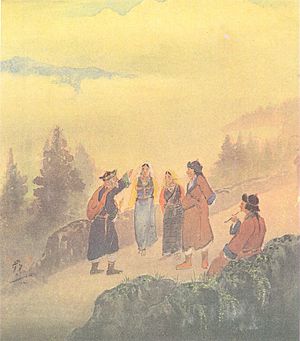
Many cultures have a long history of telling stories out loud. This happened long before books or the internet. Storytelling was used to explain things in nature. Bards (storytellers) told tales of how the world began and created stories about gods and myths. Oral stories were passed down through families and communities. Storytellers were often seen as healers, leaders, teachers, and entertainers. Oral storytelling could be songs, poems, chants, or dances.
A researcher named Albert Lord studied oral stories from the 1930s. He found that a lot of these stories were made up on the spot as they were being told. Lord noticed two main types of "story vocabulary." The first he called "formulas." These are specific phrases that are repeated, like "Rosy-fingered Dawn" or "the wine-dark sea" from ancient Greek stories. Lord found that in many oral stories, about 90% of a long story is made from lines that are repeated exactly or with just one word changed. This means oral stories are built from set phrases that storytellers learn over their lives.
The second type of story vocabulary is "theme." This is a set order of actions that structure a story. Just as storytellers use formulas for lines, they use themes for events. A common theme is repetition, like the "rule of three" in Western folklore: three brothers go on a journey, three tries are made, three riddles are asked. A theme can be simple, like how a hero gets ready for battle. Or it can be a big part of the plot. For example, a hero plans to go to a dangerous place, disguises themselves, fools everyone except one ordinary person (like an old woman), who recognizes them and becomes their helper. A theme doesn't belong to just one story; it can be found in many different tales.
The writer Reynolds Price said: "A need to tell and hear stories is essential to the species Homo sapiens – second in necessity apparently after nourishment and before love and shelter." He meant that humans need stories almost as much as food. We hear stories all the time, from small tales about our day to big, complex ones. In today's world, people will try to find stories to fill "story vacuums." If a situation is unclear or urgent, people will look for believable stories. Once a story is believed, it's very hard to change that belief, whether the story is true or not.
Märchen and Sagen
Experts who study folktales sometimes divide oral stories into two main groups: Märchen and Sagen. These are German words that don't have exact English matches, but we have close ideas:
- Märchen (pronounced MAIR-shen) are like "fairy tale(s)" or little stories. They happen in a special "once-upon-a-time" world that isn't a real place or time. They are clearly not meant to be taken as true. These stories have clear events and characters who are often simple, without deep feelings. When magic happens, it's just presented as a fact, without surprise. There's usually not much emotion in these stories, even if scary things happen.
- Sagen (pronounced ZAH-gen) are like "legends." They are supposed to have actually happened, often at a specific time and place. This makes them feel more powerful. When magic or supernatural things happen in a Sagen, it's usually very emotional. Ghost stories and Lovers' Leap tales fit into this group, as do many UFO stories.
Another important book about oral traditions is Orality and Literacy: The Technologizing of the Word (1982) by Walter J. Ong. Ong studied what makes oral traditions special. He looked at how oral and written cultures affect each other and how they shape what we know.
Learning Through Stories
Storytelling is a great way to share and understand experiences. Stories are found everywhere and can connect people from different cultures, languages, and ages. Storytelling can be changed for any age group, so everyone can enjoy it. It's used to teach about ethics, values, and cultural rules. Learning works best when it happens in social settings where you see how knowledge is used in real life. Stories help pass on knowledge in a social way.
Every story usually has three parts:
- The Setup: This is the hero's world before the adventure begins.
- The Confrontation: This is when the hero's world gets turned upside down.
- The Resolution: The hero wins, but they (or their world) must change.
Any story can fit into this pattern.
Human knowledge is built on stories. Our brains are made to understand, remember, and tell stories. We are storytelling creatures who live lives full of stories. Stories are like how we think, because we often remember facts in story form. Facts can be seen as small parts of a bigger story. So, storytelling can help us think more deeply. Because storytelling uses our hearing and sight, we can learn to organize our thoughts, understand language, and express ourselves better.
Stories often come from learning by doing. But just having an experience doesn't mean you learn from it automatically. Sometimes, you need to try telling the story of that experience before you truly understand its value. When you tell a story, not only does the listener learn, but you also become more aware of your own unique experiences. This process of storytelling can make you feel stronger. You learn to share ideas effectively, and with practice, you can show what people are capable of. Storytelling uses what we already know and helps us connect with others to find solutions.
Stories are good teaching tools because listeners get involved and remember them. Storytelling can be a base for learning and teaching. When you listen to a story, you can imagine new ideas and feel what others feel. This means you can actively join the story, observe, listen, and participate with a little help. Listening to a storyteller can create strong personal connections. It can also help with solving problems and building shared understanding for the future. You can then use what you know and imagine new possibilities. Together, a storyteller and listener can find good ways to do things and invent new solutions. Because stories often have many layers of meaning, listeners must pay close attention to find the hidden knowledge. Storytelling teaches children to respect others by listening carefully. It also connects children to their environment through story themes. And it helps them learn to learn by using repeated phrases. It also teaches children to respect all life, value connections, and always try to overcome challenges. To teach this, a Kinesthetic learning style can be used, involving listeners through music, dream interpretation, or dance.
In Indigenous Cultures
For indigenous cultures in the Americas, storytelling is a way of speaking that shares important practices and values. These stories help shape a person's identity. Everyone in the community can add their own ideas to the story. Both individual and shared cultural views are part of creating the story together. Oral storytelling in indigenous communities is different because it's not just for fun. It's also for teaching values. For example, the Sto:lo community in Canada tells stories about the land. These stories help children understand their roles in the community.
Storytelling also teaches younger members of indigenous communities about their culture and who they are. In one study, Navajos talked about their storytelling traditions. They said that storytelling has a big impact on their children's lives. Many Navajos believe storytelling is one of the main ways to teach children important rules for living a good life. In indigenous communities, stories pass knowledge from one generation to the next.
For some indigenous people, the physical and spiritual worlds are not separate. So, they teach their children through rituals, storytelling, or talking. Community values, learned through stories, help guide future generations and build identity.
In the Quechua community in Peru, adults and children are not separated. This means children learn storytelling by making their own sense of the stories. Children in the Quechua community are encouraged to listen to stories to learn about their identity and culture. Sometimes, children are expected to sit quietly and listen carefully. This helps them learn on their own.
This way of teaching through storytelling lets children form ideas based on their own experiences. In Navajo communities, storytelling is a very good way to teach both young and old about their cultures, identities, and history. Storytelling helps Navajos know who they are, where they come from, and where they belong.
Storytelling in indigenous cultures is often done out loud in a calm, relaxed setting. This usually happens at family or community gatherings, or at special events like rituals. During the story, children might join in by asking questions, acting out parts, or telling small sections. Also, stories are often not told the same way twice. This means there are many versions of one myth. Storytellers might add new things to old stories depending on who is listening. This makes the story fit each unique situation.
Indigenous cultures also use instructional ribbing in their stories. This is a playful way to correct children's bad behavior. For example, the Ojibwe (or Chippewa) tribe tells a story about an owl that snatches away misbehaving children. A caregiver might say, "The owl will come and stick you in his ears if you don't stop crying!" This kind of teasing helps correct behavior and encourages cooperation.
Types of Stories
There are many types of stories in indigenous communities. Communication in Indigenous American communities is full of stories, myths, and narratives. These stories share information. They can be about growing up, core values, morals, reading skills, and history. Often, stories teach children about cultural values and lessons. The meaning in the stories is not always clear. Children are expected to figure out the meaning for themselves. For example, in the Lakota Tribe, young girls hear the story of the White Buffalo Calf Woman. She is a spiritual figure who protects young girls. In the Odawa Tribe, young boys hear about a young man who didn't take care of his body. As a result, his feet couldn't run when he tried to escape danger. This story indirectly encourages boys to take care of their bodies.
Stories can be shared to show the values or morals among family, relatives, or close community members. Many stories in indigenous American communities have a "surface" story. This means you need certain information to understand the hidden meanings. The deeper message can be understood with clues in the story. To understand these stories, elders in the Sto:lo community say it's important to learn how to listen. This means bringing your heart and mind together. For example, children learn about important meanings by listening to elders and taking part in rituals where everyone respects each other.
Passing on Values
Stories in indigenous cultures share many values. These include focusing on personal responsibility, caring for the environment, and helping the community.
Stories are based on values passed down from older generations. These values shape the community. Storytelling connects knowledge and understanding. It helps link the values of "self" and "community" so they are learned together. In the Navajo community, storytelling helps teach community values at different times and places to different learners. Stories are told from the point of view of other people, animals, or nature. This way, children learn to value their place in the world in relation to others. Stories are usually an informal learning tool in Indigenous American communities. They can be a gentle way to correct children's behavior. This makes stories non-confrontational, allowing the child to figure out what they did wrong and how to fix it.
Parents in the Arizona Tewa community, for example, teach morals through traditional stories. Lessons cover topics like historical or "sacred" stories, or everyday problems. Through storytelling, the Tewa community highlights the wisdom of their ancestors. They also stress the importance of both group and individual identities. Indigenous communities teach children valuable skills and morals through the actions of good or mischievous characters. They also leave room for children to make their own meaning. By not giving every detail, children use their own experiences, not just formal teaching, to fill in the gaps.
When children listen to stories, they often show they are paying attention. They accept that the storyteller will speak for a while. The focus on paying close attention to what's happening around them, and the importance of oral tradition, teaches children to be very observant. For example, children from the Tohono O'odham American Indian community who took part in more cultural practices remembered stories better than those who didn't. Body movements and gestures help share values and keep stories alive for future generations. Elders, parents, and grandparents usually teach children about cultural ways, history, community values, and lessons about the land.
Children in indigenous communities can also learn from the hidden message of a story. For example, in a Nahuatl community near Mexico City, stories about ahuaques (hostile water spirits) teach about respecting the environment. If a story's main character accidentally breaks something belonging to an ahuaque and doesn't replace it, the protagonist dies. This way, storytelling teaches what the community values, like caring for nature.
Storytelling also delivers special messages during spiritual events. In these cases, the message's theme of unity is more important than the time, place, or characters. Once the message is given, the story is done. As stories are told again and again, parts of the tale can mix and match. This shows different results for a person's actions.
Research on Storytelling
Storytelling has been studied to see how it helps with reading skills and learning theater terms. One researcher in the UK suggests that the social space created before oral storytelling in schools might encourage sharing.
Storytelling has also been looked at as a way to study and save cultural knowledge and values in indigenous American communities. A study by Iseke (2013) on the role of storytelling in the Métis community showed how important it was for sharing and being part of the community. Métis members would stop everything to listen to a storyteller. This made the story a "ceremonial landscape," or a shared reference, for everyone there. This was a powerful way for the community to teach new learners about Métis values and ideas. Through storytelling, the Métis created shared understandings of personal or popular stories and folklore. Métis elders hoped these stories would be used for future research into their culture, as stories were a traditional way to pass down important knowledge to younger generations.
For the stories we read, our brains process narratives at a higher level than just individual words. This processing seems to happen in a specific part of the brain called the default mode network.
Storytelling in Business
People have used stories at work for a very long time. In ancient times, stories might inspire "courage and empowerment during the hunt for a potentially dangerous animal." Or they might simply teach the value of listening. Today, storytelling in business has become its own field. This is partly because industries have grown, and storytelling has become more popular in general.
In the Workplace
In the workplace, using storytelling to share information can be more interesting and effective than just using dry facts. Here are some ways it's used:
- To Manage Problems: For managers, storytelling is an important way to solve problems and deal with challenges. Managers might use stories to handle conflicts when direct action isn't a good idea or is impossible.
- To Understand the Past and Plan the Future: In group talks, telling stories together can help influence others and unite the group. It connects what happened in the past to what will happen in the future. In these talks, managers turn problems and requests into stories. This is called "story building."
- In Decision-Making: Storytelling is important in making decisions and convincing others. In business meetings, managers often prefer stories over just facts or numbers. When situations are complicated, stories help solve problems, influence company decisions, and make the group stronger.
In Marketing
Storytelling is used more and more in advertising to make customers feel loyal to a brand. This marketing trend shows how much people love to be entertained. Stories are easy to understand, easy to remember, and help companies create stronger emotional connections with customers.
A study by Nielsen shows that people want a more personal connection when they get information. Our brains are more interested in stories than just facts. When you read only data, only the language parts of your brain work. But when you read a story, both the language parts and the parts of the brain that would be active if you were actually experiencing the story are turned on. Because of this, stories are easier to remember than facts.
Marketing now uses "trans-media" techniques, which came from the film industry. The idea is to "build a world where your story can grow." An example is the "Happiness Factory" campaign by Coca-Cola.
See also
 In Spanish: Narración de historias para niños
In Spanish: Narración de historias para niños
- Dramatic structure
- Story arc
- Storyboard
- Storytelling festival
- Storytelling game
- World Storytelling Day
- Story Shaper


